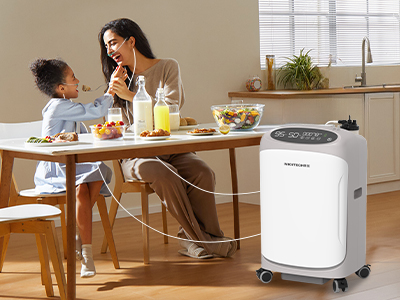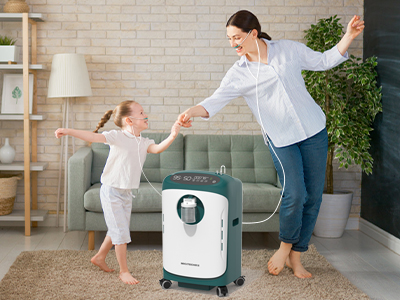03 Jan 2025
Oxygen therapy is a lifeline for individuals grappling with respiratory conditions such as COPD, pulmonary fibrosis, or severe asthma. At the heart of this therapy lies a critical element: the oxygen concentrator's liter flow. This seemingly simple setting dictates the rate at which oxygen is delivered, playing a pivotal role in maintaining proper blood oxygen levels.

What Is Liter Flow?
Liter flow refers to the volume of oxygen delivered per minute through a concentrator, measured in liters per minute (LPM). It essentially controls how much oxygen a patient receives at any given time. For individuals with compromised lung function, an adequate and consistent liter flow is crucial to ensuring their tissues and organs receive sufficient oxygen to function optimally. The prescribed flow rate is often tailored to individual medical conditions, ensuring patients neither receive too little oxygen nor more than they need.
How Liter Flow Is Measured
Liter flow is quantified in liters per minute (LPM), with most concentrators offering a range of settings that can be adjusted as needed. These settings are controlled using flow meters or digital interfaces, depending on the concentrator model. For patients requiring precision, modern oxygen concentrators use advanced technology to ensure accurate delivery rates, even under varying conditions. The ability to fine-tune liter flow allows healthcare providers to customize therapy based on diagnostic assessments and patient feedback.
Matching Liter Flow to Patient Needs
The liter flow required by a patient is far from arbitrary; it is carefully prescribed based on their unique medical condition and oxygen saturation levels. For instance, a patient with COPD may require a lower flow rate compared to someone recovering from acute respiratory failure. Incorrect liter flow settings can lead to significant risks. Insufficient oxygen delivery can result in hypoxemia, causing fatigue, confusion, or organ damage. Conversely, excessive oxygen intake can suppress respiratory drive in certain conditions, leading to complications such as hypercapnia.
High-Flow vs. Low-Flow Oxygen Therapy
Oxygen therapy is broadly categorized into high-flow and low-flow systems, each designed for specific needs. Low-flow therapy, often delivered at rates of 1–5 LPM, is suitable for patients with mild to moderate oxygen needs. High-flow therapy, which can deliver up to 60 LPM, is reserved for patients requiring intensive respiratory support, such as those in critical care or managing advanced lung diseases. Understanding these distinctions helps patients and caregivers identify the most appropriate equipment and settings for effective therapy.

Factors That Influence the Required Liter Flow
Oxygen demand fluctuates based on several factors, making it essential to adjust therapy accordingly. Physical activity significantly impacts oxygen requirements; even simple tasks like walking or climbing stairs can increase the need for supplemental oxygen. Similarly, nighttime oxygen demands may differ due to changes in breathing patterns during sleep. Healthcare providers often recommend different settings for resting and active states to ensure continuous oxygenation throughout the day.
Adjusting Liter Flow: Guidelines and Precautions
Adjusting liter flow settings should always be done under medical supervision. While it may be tempting to increase or decrease the flow rate based on how one feels, unauthorized changes can disrupt the delicate balance needed for effective therapy. For example, increasing the flow rate unnecessarily may deplete oxygen supplies faster without offering additional benefits, while reducing it can lead to dangerously low oxygen levels. Regular check-ins with a healthcare provider ensure that any adjustments are both safe and effective.
The Role of Pulse Dose and Continuous Flow
Oxygen concentrators deliver oxygen in two primary modes: pulse dose and continuous flow. Pulse dose provides oxygen in short bursts during inhalation, conserving oxygen and making it ideal for active users. Continuous flow, on the other hand, delivers a steady stream of oxygen, making it suitable for patients with higher or more consistent needs. Understanding the interplay between these delivery modes and liter flow settings allows patients to choose equipment that best aligns with their lifestyle and medical requirements.
Testing and Monitoring Oxygen Levels
Monitoring blood oxygen levels is integral to ensuring that the prescribed liter flow is meeting a patient’s needs. Pulse oximeters, which measure oxygen saturation in the blood, are commonly used for this purpose. In more complex cases, arterial blood gas (ABG) tests provide a comprehensive assessment of oxygen and carbon dioxide levels. If a patient experiences symptoms such as shortness of breath, dizziness, or confusion despite using oxygen therapy, it may signal the need to reassess their current flow rate.
Conclusion
The liter flow setting on an oxygen concentrator is more than just a number—it is a lifeline that ensures oxygen therapy is effective and safe. By understanding how liter flow works, patients can better appreciate the intricacies of their treatment and avoid common pitfalls. Regular consultations with healthcare providers, combined with diligent monitoring, empower patients to optimize their oxygen therapy and maintain an improved quality of life. Proper adherence to prescribed liter flow is not just a medical necessity—it is a step toward greater vitality and well-being.
Keywords: oxygen concentrator
Originally published 03 Jan 2025, updated 03 Jan 2025.